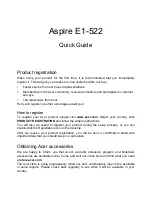
69
Appendix
A
Laser Classifications
As lasers became more numerous and more widely used, the need to warn users of laser hazards be-
came apparent. To meet this need, laser classifications were established. Current classification levels
vary from optically safe, requiring no controls (Class 1) to very hazardous, requiring strict controls
(Class 4).
CLASS 1: A Class 1 laser or laser system emits levels of optical energy that are eye-safe and
consequently require no controls. An example of this class of laser system is the checkout
scanning device found in most grocery stores or lasers used in optical drives.
CLASS 2 AND CLASS 3A: Class 2 and Class 3A lasers emit visible, continuous-wave (CW)
optical radiation levels slightly above the maximum permissible exposure (MPE) level. Al-
though these lasers can cause eye damage, their brightness usually causes observers to look
away or blink before eye damage occurs. These lasers have strict administrative controls re-
quiring placement of signs warning personnel not to stare directly into the beam. Class 3A
lasers must not be viewed with optically-aided devices.
CLASS 3B: Class 3B lasers, and Class 3A lasers with outputs of 2.5mW, are hazardous to
personnel who are within the beam path and look at the beam source directly or by specular
reflection. These lasers cannot produce hazardous diffuse reflections. Personnel working with
these lasers should wear appropriate protective eyewear during any operation of the laser.
Class 3B lasers have both administrative and physical controls to protect personnel. Physical
controls include limited access work areas. Administrative controls include special warning
signs posted outside the entrances to the laser work spaces and lights outside the entrances that
warn personnel when the lasers are in use.
CLASS 4: Class 4 lasers are high-power lasers that will cause damage to unprotected eyes and
skin through intra-beam viewing and specular or diffuse reflections. Consequently, no person-
nel should be in aroom where a Class 4 laser is operating without proper eye protection.
LPT Port (Line Printer Port)
Logical device name reserved by DOS for the computer parallel ports. Each LPT port is configured to
use a different IRQ and address assignment.
PCI Bus (Peripheral Component Interconnect Local Bus)
PCI bus is a specification that defines a 32-bit data bus interface. PCI is a standard widely used by
expansion card manufacturers.
PC Cards (PCMCIA)
PC cards are about the size of a few stacked credit cards and have a 68-pin connector at one end. The
PC Card standard accommodates a number of function, communication, and data storage expansion
options. PC cards come in memory/flash cards, fax/modems, networking adapters, SCSI adapters, MPEG
I/II decoder cards, and even wireless modem or LAN cards. The Notebook PC supports PCMCIA 2.1,
and 32-bit CardBus standards. The three different PC Card standards actually have different thick-
nesses. Type I cards are 3.3mm, Type II cards are 5mm, and Type III cards are 10.5mm thick. Type I and
Type II cards can be used in a single socket. Type III cards take up two sockets and must be used on
Notebook PCs with two sockets.
Summary of Contents for E2334
Page 1: ...E2334 Nov 2005 Notebook PC Hardware User s Manual ...
Page 10: ...10 ...
Page 14: ...14 1 Introducing the Notebook PC ...
Page 15: ...15 2 Knowing the Parts Basic sides of the Notebook PC ...
Page 38: ...38 3 Getting Started ...
Page 56: ...56 4 Using the Notebook PC ...
Page 71: ...71 Appendix A ...






































